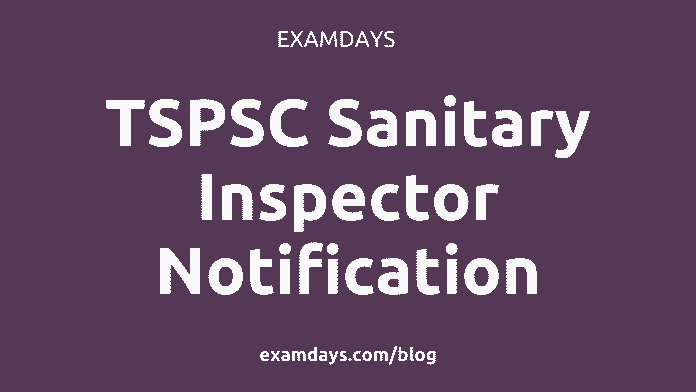TSPSC Sanitary Inspector Notification 2023: Telangana State Public Service Commission (TSPSC) released a notification to fill the Telangana TSPSC Sanitary Inspector Notification 35 vacancy posts, the online application can be available from July 25th onwards, those who are interested to apply for TSPSC Jobs in Telangana State can check Candidate eligibility, Age, Qualification, Location of Post, Job Responsibilities, TSPSC Salary, Bill Collector Salary.
The Number of Vacancies is announced in the month by Telangana TSPSC Authorities and the recruitment is to be finished in under 3 months as a pilot project level.
TSPSC Sanitary Inspector Notification 2023
- The Total number of vacancy Posts are announced: 35 Vacancy Posts.
- Name of the Posts: Bill Collector.
- Age Assigned for Candidate: 18 – 44 Age and age relaxation can apply for reserved candidates. Minimum 18 years & Maximum 44* years. The age is reckoned as on 01/07/2018
- Telangana TSPSC Scale pay/ Salary/ Pay is Rs.22,460/- to Rs.66,330/–
| Post Name | Vacancies | Age as on 01/07/2023 | Scale of Pay Rs. |
| Sanitary Inspector | 35 | 18-44* | 22,460 – 66,330/- |
Candidate Qualification | Telangana TSPSC Sanitary Inspector Notification
- Must possess a Bachelor’s Degree in Biological Science from any University in India or incorporated by or under Central Act, Provincial Act, or a State Act or an Institution recognized by the UGC or an equivalent qualification.
- Sanitary Inspector Training Course certificate awarded by the Chairman, Board of Examinations constituted by the Government of Telangana or from Government of India / Government of Telangana Recognized Institution.
Application Fee | Telangana TSPSC Sanitary Inspector Notification
Each applicant must pay Rs. 200/- (RUPEES TWO HUNDRED ONLY) towards Online Application Processing Fee. Apart, the applicants have to pay RS. 80/- (EIGHTY RUPEES ONLY) towards Examination Fee. However, the following category of candidates is exempted from payment of Examination fee.
Telangana TSPSC Exam Centers | Telangana TSPSC Sanitary Inspector Notification
The Written Examination (Objective Type) will be held at the following centers or as may be decided by the Commission. Those who applied for TSPSC Sanitary Inspector can choose the below-listed examination centers as per choice in ascending order.
- HYDERABAD
- KARIMNAGAR
- KHAMMAM
- WARANGAL
- NIZAMABAD
- MAHABOOBNAGAR
- RANGA REDDY
- MEDAK
- NALGONDA
- ADILABAD
Important Dates | Telangana TSPSC Sanitary Inspector Notification
- Submission of ONLINE applications from Date: 25/07/2018.
- Last date for submission of ONLINE applications Date: 10/08/2018.
- The Examination is likely to be held on Date: 07/10/2018.
TSPSC Sanitary Inspector Syllabus
Candidate checks the Telangana TSPSC Sanitary Inspector Syllabus 2018, which is published by the TSPSC officials on July 24th, 2018, the syllabus is available in English and Telugu languages.
Attempt Telangana TSPSC Quiz Tests in Telugu and English
| Written Examination (Objective Type) | No.of Questions | Duration (Minutes) | Maximum Marks |
| Paper-I: General Studies and General Abilities | 150 | 150 | 150 |
| Paper-II: Biological Science (Degree Level) : | 150 | 150 | 150 |
| Total | 300 |
Animal Physiology ( with special reference to mammals )
Digestion and Absorption: Role of salivary glands, liver, pancreas, and intestinal glands; Respiration –Mechanism of respiration, Transport and exchange of gases; circulation – Open and closed circulation, heartbeat and cardiac cycle, myogenic and neurogenic hearts ; excretion –Nephron and regulation of urine formation; osmoregulation and excretory products; muscles –Types , mechanism
Paper-I: General Studies and General Abilities
- Current Affairs – Regional, National, and International
- International Relations and Events.
- General Science; India’s achievements in Science and Technology
- Environmental issues and Disaster Management
- The economy of India and Telangana
- Geography of India with a focus on Telangana
- Indian Constitution and Polity with a focus on local self Government
- Society, Culture, Heritage, Arts, and Literature of Telangana
- Policies of Telangana State
- History of Modern India with a focus on the Indian National Movement
- History of Telangana with special emphasis on Movement for Telangana Statehood
- Logical Reasoning, Analytical Ability, and Data Interpretation
- Basic English
PAPER. II. Biological Science (Degree Level)
Botany
Unit – I – Microbial diversity Cryplogams and Gymnosperms
Economic importance of Bacteria and plant diseases caused by bacteria and their ycontrol – Viruses-structure, replication and transmission, plant diseases caused by viruses and their control. Brief Account of Cyanobacteria – Cell structure, thallus organization and their uses – Biofertilizers – General Account and classifications of Algae, Fungi, Bryophytes, Pteridophytes and Gymnosperms – Economic importance of Algae, Fungi – Lichens – structure and reproduction, ecological economic importance. Evolution of sporophyte in Bryophytes – Evolution of stele, heterospory and seed habit in Pteridophytes – Palaeobotany: Introduction, Fossils and fossilization: Geological time scale.
Unit – II – Anatomy, Embryology, Taxonomy and Medicinal Botany
Tissues and tissue systems, Normal and Anomalous Secondary growth, wood anatomy, General Account – Microsporogenesis, Megasporogenesis, Pollination, fertilization Endosperm, apomixis and Palynology – Types of classification, systems of classification Bentham and Hooker, Engler and Prantle, APG – Current concepts in Angiosperm Taxonomy- Embryology in relation to Taxonomy, Cytotaxonomy, Chemotaxonomy and Numerical -taxonomy. Ethnomedicine: scope, interdisciplinary nature, distinction of Ethnomedicine from Folklore medicine. Outlines of Ayurveda, Sidda, Unani and Homeopathic systems of traditional medicine. Role of AYUSH, NMPB, CIMAP and CDRI – Pharmacognosy: Introduction and scope. Adulteration of plant crude drugs and methods of identification – some examples. Indian Pharmacopoeia – Plants crude drugs: Types, methods of collection, processing and storage practices – Evaluation of crude drugs.
Unit – III – Plant Physiology
Water Relations: Importance of water to plant life, physical properties of water, diffusion, imbibition, osmosis; water, osmotic and pressure potentials – absorption, transport of water, ascent of sap; transpiration; Stomatal strtructure and movements – Mineral Nutrition: Essential macro and micro mineral nutrients and their role; symptoms of mineral deficiency; absorption of mineral ions; passive and active processes – Enzymes: Nomenclature, characteristics, mechanism and regulation of enzyme action, enzyme kinetics, factors regulating enzyme action – Photosynthesis: Photosynthetic pigments, absorption and action spectra; Red drop and Emerson enhancement effect; concept of two photosystems – mechanism of photosynthetic electron transport and evolution of oxygen; photophosphorylation; Carbon assimillation pathways: C3, C4 and CAM; photorespiration – Translocation of organic substances: Mechanism of pholem transport; source-sink relationships – Respiration: Aerobic and Anaerobic; Glycolysis, Krebs cycle; electron transport system, mechanism of oxidative phosphorylation, Pentose phosphate pathway – Nitrogen Metabolism: Biological nitrogen fixation, nitrate reduction, ammonia assimilation, amino acid synthesis and protein synthesis – Growth and Development: Definition, phases and kinetics of growth. Physiological effects of phytohormones – auxins, gibberellins, cytokinins, ABA, ethylene and brassinosteroids – Physiology of flowering and photoperiodism, role of phytochrome in flowering.
Unit – IV- Genetics, Tissue, Culture and Biotechnology
Mendelism: Laws of inheritance. Genetic interactions – Epistasis, complementary, supplementary and inhibitory genes – Linkage and crossing over: A brief account, construction of genetic maps – 2 points and 3 points test cross data – Mutations: Chromosomal aberrations – structural and numerical changes; Gene mutations – Gene Expression: Organisation of gene, transcription, mechanism and regualtion of gene expression in prokaryotes (Lac.and Trp Operons) – Extra nuclear genome: Mitochondrial and plastid DNA, plasmids – Tissue cluture: Introduction, sterlization procedures, culture media – compositon and preparation; explants – Callus culture; cell and protoplast culture, Somatic hybrids and cybrids – Applications of tissue culture: Production of pathogen free plants and somaclonal variants, production of stress resistance plants, secondary metabolites and synthetic seeds – Biotechnology: Introduction, history and scope – DNA technology: Vectors and gene cloning and transgenic plants.
Zoology Unit-1:
Non chordata and chordata : General characters, classification and relationship of various phyla up to subclasses in non-chordata; canal system in sponges, polymorphism, coral reef and their formation in Cnidaria. Coelom and coelomoducts in annelida; larval forms in Crustacea; Peripatus- General characters and significance, pearl formation in mollusca ; Hemichordate- structure and affinities of Balanoglossus, Protochordata- General featuers of Urochordata and Cephalochodata, Characters and classification of Chordates upto orders migration in fishes and types of scales, parental care in amphibians, flight adaptations and migration in birds, dentition in mammals .
Unit-2
1 .Cell biology : Structure and function of cell and its organelles ( nucleus, plasma membrane, endoplasmic reticulum, golgi bodies, ribosomes, lysosomes, and mitochondria), cell division (mitosis and meiosis ) ,chromosomes- Structure and types, cell cycle regulation, nucleic acids -Structure of DNA and RNA, types of RNA .
- 2. Embryology : Gametogenesis-Spermatogenesis and Oogenesis ,fertilization, types of eggs, types of cleavages, development of frog upto gastrulation and formation of germ layers, foetal membranes and their significance, placenta- types and functions, regeneration with reference to turbellarians and lizards .
Unit-3
of contraction of skeletal muscles;neuron-Nerve impulse,Its conduction and synaptic transmission ,neurotransmitters, endocrine glands(pituitary, thyroid, parathyroid, pancreas,adrenal, gonads)and their interrelationships .
2.Ecology : Concept of biosphere,biomes, the concept of an ecosystem; abiotic and biotic factors, biogeochemical cycles, productivity, community interaction- Brief account on competition, predation, mutualism, commensalism and parasitism; types of ecological succession; population–Characteristics,population dynamics,population stabilization, air, water, soil, and noise pollution, Environmental protection act, wild life and its conservation
3.Evolution : Theories of evolution;natural selection ,role of mutations in evolution ,evolutionary patterns,mimicry variation,isolation and speciation (allopatry and sympatry),Hardy-weinberg law,Zoogeographical realms and their characteristic fauna.
Unit-4: Applied Zoology
1.Fisheries and Aquaculture: Types of fisheries, fishery resources from fresh water, brackish water and marine habitats, fin fish and shell fisheries, fishing gears and fishing crafts, Induced breeding, Hatchery design and management, Larval rearing- Nursery ponds, rearing and grow out ponds, shrimp and prawn culture, preservation and processing –Freezing, solar drying, canning, salting, smoking.
2.Clinical Science: Composition and constituents of blood; blood groups and Rh factor in man, blood diseases- anemia, leukemia, leucopaenia, biopsy and autopsy –Clinical importance, Immunoglobulin, immunity and hypersensitivity; Human parasites- Structure and clinical significance of Plasmodium, Entamoeba, Taenia and Ancylostoma.
- Animal Biotechnology : Scope of biotechnology, Transgenic animals; Stem cells-Sources, types and their use in human welfare.
ANALYSIS OF Sanitary Inspector Notification
- Number of Posts: 35 Posts
- Applications Received: Pending to Update
- Competition of Each Post: Pending to Update
- Languages Opt: English, Telugu, and Urdu.
- Number of Questions: 300 Questions
- Number of Marks: 300 Marks
- Exam Duration: 300 minutes
- Mode examination: Offline / Online
- Type of Exam: Objective and Descriptive
- Negative Mark: No
Examdays Article Agenda


